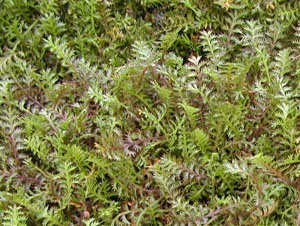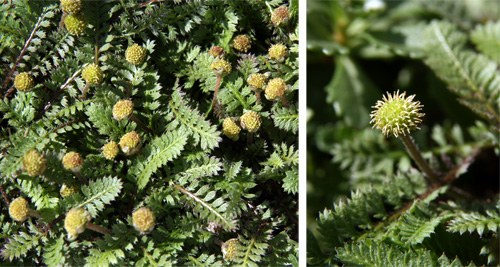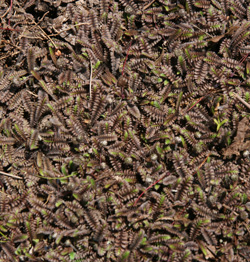
Brass buttons, Leptinella squalida (formerly Cotula squalida), is an unusual, very low-growing plant in the daisy family (Compositae). This is one of about 30 species in this genus occurring in Australasia and southern South America. In its native New Zealand this creeping herbaceous perennial is found in open, damp places in lowland to sub-alpine regions of North, South and Stewart Islands. Hardy in zones 4-10, it only grows about half an inch to 2” high but spreads to form dense mats of foliage.

The feathery or fern-like leaves are a dull grayish-green with gray, purple, and black tints. The delicate-looking leaves grow up to 2” long and ½“ wide (but are often much smaller). This species is evergreen in milder climates (zones 9-10); its leaves will remain under snow cover in colder climates (although they turn rather reddish or dark colored rather than their normal green) but plants die back to the ground when exposed. If plants do die back over the winter they will not look their best early in the spring. The leaves fill in by late spring and look good throughout the rest of the growing season. In autumn they turn a bronze, brassy or purple color.

Tiny, yellowish-green to gold flowers are produced in spring. They are composed of just the central disk flowers of the normal daisy flower (called disciform), and minus the white ray flowers, they appear something like miniature buttons – giving rise to the common name of brass buttons.

Flowers are followed by tiny capsular fruit. The flowers and fruit are not very conspicuous, however, partly because of the size, but also because of the color that doesn’t stand out from the foliage. Because of its short stature and small flowers, most people don’t bother to deadhead plantings. However, a lawn mower could be used to remove spent flowers on larger plantings.
Brass buttons does best in full sun in cooler climates, but needs part shade in hotter climates. It prefers acidic, loamy soil rich in organic matter, but adapts to many other soil types. Because it is very shallow rooted, it does best with annual fertilization except in very fertile soils. It is not drought tolerant and needs regular watering, especially on light soils. It does not do well in compacted soil and may need to be lifted and replaced after loosening and amending the soil if it is languishing after a few years. It has few insect or disease problems.

This plant spreads aggressively by rhizomatous runners just under or on the soil surface. In heavy clay, it spreads more slowly than when grown on light soils. It will continue to spread indefinitely as new sections root. It can be easily propagated by division in spring or early fall – just dig up a clump, cut it into pieces and move it to another spot. Space newly purchased plants about a 9-12” apart.
Brass buttons is typically used as a ground cover for small areas, in rock gardens and as a turf substitute in mild climates. It tolerates very light foot traffic, so it is well suited to grow between flagstones or along the edges of pathways. Combine it with Scotch moss (Sagina subulata) for good contrast in texture between stepping stones. It can be a good stand-in for moss in places that are too sunny for most mosses or makes an interesting addition to containers as a ground cover under larger plants.

The very small scale of L. squalida would make it a good addition to a railroad garden or other miniature landscape for its fern-like appearance.
The most common variety is ‘Platt’s Black’ which was a sport discovered in the garden of Jane Platt of Portland, Oregon. This variety has nearly black leaves with a bright green tip and dark-colored flowers. Some people like it but other think it looks blighted or dying. It looks particularly good in contrast with bright green, gold or chartreuse-foliaged companion plants, such as golden Scotch moss. Other similar species may also be offered, including L. perpusilla.
– Susan Mahr, University of Wisconsin – Madison
Latest from Wisconsin Yard & Garden
Ask Your Gardening Question
If you’re unable to find the information you need, please submit your gardening question here:





 Aster, Symphyotrichum spp.
Aster, Symphyotrichum spp. Fascinating Fasciation
Fascinating Fasciation Alternatives to Lawn: Groundcovers
Alternatives to Lawn: Groundcovers Marigolds
Marigolds


